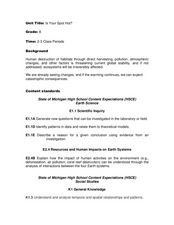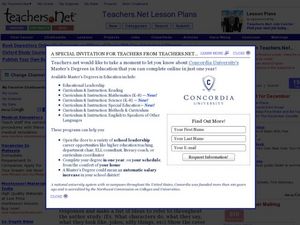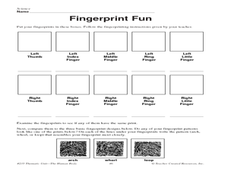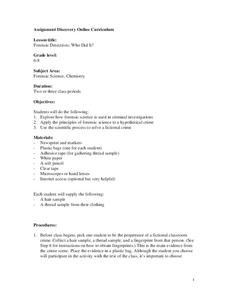University of Colorado
Patterns and Fingerprints
Human fingerprint patterns are the result of layers of skin growing at different paces, thus causing the layers to pull on each other forming ridges. Here, groups of learners see how patterns and fingerprints assist scientists in a...
Curated OER
Fingerprint Fun
In this science worksheet, students investigate the unique characteristics of human fingerprints by first making a print of every digit in the labeled boxes. Students then examine their fingerprints, looking for an arch, whorl or loop.
Curated OER
Human Fingerprints: No Two The Same
Learners will be offered numerous opportunities to further enhance their observational skills as well as the integration of math with their continual exposure to the metric system, measurement, and graphing to represent their data....
Curated OER
Is Your Spot Hot?
Eighth graders explore global warming. In this Earth Science lesson plan, 8th graders will look for Harbingers and fingerprints for different areas. The students will identify an area at risk and they will then create a presentation to...
Curated OER
Fabulous Forensic Fingerprints
Learners explore the uniqueness of each person's individual body. They identify traits and characteristics of the human body, with a main focus on the uniqueness of fingerprints and footprints. Students examine and compare fingerprints....
Curated OER
Hunt for the Serial Arsonist
Students prepare study, and graph fingerprint patterns. They create latent fingerprints and look for common features in their prints for classification.In addition, they create a graph showing the distribution of different patterns...
Curated OER
Robert Munsch: Author Study
Students study Robert Munsch's style of writing. In this literature lesson, students read many of Robert Munsch's books, write a list of the characteristics found in his books, and write or orally tell a story using some of these...
Curated OER
Fingerprints
Students analyze their fingerprints. In this fingerprint lesson, students make prints and observe the patterns for arches, loops, and whorls. They write a brief autobiography about themselves titled "I'm Thumbody."
Curated OER
Crime School Investigations
Students solve a mystery at their school. In this classifying instructional activity, students find suspects who committed the crime. Students categorize them into race, sex, and fingerprint type. Students show their results in graphs.
Curated OER
Investigating Fingertips
In this fingerprints worksheet, students 10 boxes with imprints of their own fingerprints. Students must press their fingertips on ink and create prints which they must then compare to three diagrams and match the patterns.
Curated OER
Classroom Identity
Students explore fingerprints. In this finger prints lesson, students investigate how to classify fingerprints. Students study large pictures of fingerprints and circle the patterns they know how to identify. Students then take their own...
Curated OER
Fabulous Forensic Fingerprints
Students observe their fingerprints and notice how all human bodies are different. For this fingerprints lesson plan, students see the loops, whorls, and arches that make everyone's fingerprints different, and make a class graph for...
Curated OER
Fingered Felons
Students examine fingerprints. In this biology lesson, students use sticky tape to create their own set of prints and identify patterns on each of their fingers. Students try to solve a "classroom crime" based on the patterns of a...
Curated OER
Investigating Fingerprints
Students study the individuality of fingerprints. In this fingerprint instructional activity, students determine that each person has a unique set of fingerprints. They rub their fingertips with soft pencil lead and rub the print off on...
Curated OER
Give Me a Hand, I'm "Thumb-body" Special
Students label the bones in the hand, create a model of the hand, compile a set of fingerprints, and explore the importance of the thumb. In this anatomy of the hand lesson plan, students participate in six hands-on activities to...
Curated OER
Classification
In this classification worksheet, students observe the fingerprints provided. Students decide upon a classification system to use to categorize the given fingerprints.
Curated OER
Super Glue Fuming of Latent Fingerprints
Students explore latent fingerprinting. They observe a supervised demonstration of the process that real-life crime scene investigators sometimes use to identify latent fingerprints. In addition, they brainstorm ways to improve the...
Curated OER
Forensic Detectives: Who Did It?
Middle schoolers explore forensic science and its uses in criminal investigations. They solve a fictional crime by identifying and analyzing the fingerprints, strand of hair, and thread samples for evidence. After completing charts for...
Curated OER
Fingerprinting
Students discover the basics of fingerprinting and how it identifies a person. They create their own fingerprints and compare them to classmate's to determine that no two people have the same identity because of fingerprints. Then they...
Curated OER
DNA Fingerprinting: You Be the Judge!
Students explore DNA fingerprinting. Students discover how DNA fingerprinting is done and judge the validity. They evaluate the use of certain prints in courts and address the ethics of establishing a national database of fingerprpints.
Curated OER
"Who Done It?" Analysis of Molecular Fingerprints Left At the Scene of the Crime
Students examine different types of DNA fragments. They record and analyze their results. They determine who is the criminal in the story.
Curated OER
Whodunit?
Students observe the geometric patterns on fingerprints. They classify fingerprints into groups and obtain prints from surfaces.
Curated OER
Investigating Fingerprints
Learners observe that each individual possesses a unique set of fingerprints. The Magic School Bus series of books, "Inside the Human Body," is used in conjunction with this lesson.
Curated OER
Lifting Fingerprints
Students examine the uniqueness of each other's fingerprints through the dusting and lifting of them. They use stamp pads, powder, brushes, etc. to collect as many different prints as they can.

























